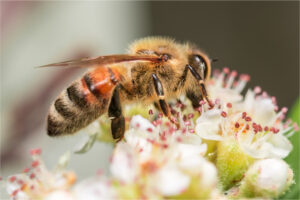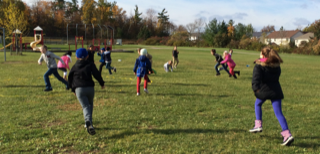Don’t Worry; BEE Happy

To view the photo-rich magazine version, click here.
Originally appears in the Fall 2022 issue.
By Frank Glew
Editor’s note: For so many of us, our entry point into the world of bees is honey bees — and why not? They’re beautiful; they’re ubiquitous; and they make honey! What’s important to remember is that in North America (where the majority of our readers reside), honey bees are not native. That’s not to say they cannot be studied; we just encourage you to pair explorations of honey bees with activities related to native bees. Fortunately, we have created six such activities as part of our Summer 2022 issue (# 132).
Engagement
 Start by reading Melissa’s Magnificent Message.
Start by reading Melissa’s Magnificent Message.
Melissa is a wise, hard-working worker bee who discovers the real reason why bees are disappearing. Everyone needs to know the importance of these little pollinators and the consequences of living without insect pollinators. Through her insight, she solves this complex problem. The name Melissa comes from the Greek word μέλισσα (melissa), “honey bee,” and from μέλι (meli), “honey.” The message in this book is based on the North American Indigenous saying, “When the last tree is cut down, the last fish eaten, and the last stream poisoned, you will realize that you cannot eat money.” The voice in the book is the voice of the bees, beekeepers, Gaia, and our children, all of whom will be dependent upon our present choices for their future sustainability.
Questions and ideas
1. Why did the author call the bee “Meli”?
2. Who was Meli’s best friend?
3. Why was Bumble Island a good place to live?
4. Why did Melissa, who was a worker bee, have a stinger?
5. Which bees do not have stingers?
6. When is the only time bees sting you?
7. Why did Melissa wonder if she should pollinate broccoli?
8. How did farmers stop insects from eating their crops?
9. Did it get rid of harmful insects?
10. Why was killing insects a bad idea for bees?
11. What were the bees’ other problems?
12. How did school children help Meli?
13. Why did farmers make bigger fields?
14. What was Meli’s big problem?
15. How did she solve her problem?
16. How did the scientists help Meli?
17. What is pollination?
18. What was Meli’s wacky song?
19. What does her song mean?
20. Are there things more important than piles of money? Name some. (e.g., food, family, water, health, friends, pets, happiness, nature, our habitat, the environment, etc.)
Higher-level questions
1. Do you know any things that people make for lots of money that are not good for us? (e.g., cigarettes, drugs, junk food, sugar, pop, guns, pesticides, bombs, etc.)
2. Discuss why people make things that are not good for us or the environment.
3. What is the author’s message in the story?
4. How could we use this message in our lives?
5. What might happen if all the bees disappeared?
6. What does Meli’s song mean in your words?
7. How could we help bees? (See “What can we do?” below.)
8. Farmers have a huge problem. They need to protect their crops from insect pests yet need them to pollinate their crops. What would you do if you were a farmer?
9. What might happen if all the beekeepers disappeared? (no one to look after or speak for the bees)
10. What is organic food?
11. Why do we need insects?
Possible extensions
1. Dramatize the story and present it to other classes or during an assembly!
2. Older students could debate the issue by playing the following roles: pesticide company, beekeepers, farmers, politicians.
3. Reading buddies could read and discuss the story with primary school students.
4. Invite a beekeeper into the classroom.
5. Research the following: bees, honey, insects, beekeepers, pesticides, colony collapse disorder (CCD), bee life cycle, three types of bees in a hive and their jobs, honey, food pollinated by bees or other insects.
Materials for core activity
Students will go outside to play the role of 1) worker bee, 2) queen bee, 3) four bee enemies. The game will simulate the workings of a honey bee beehive. You will need 8–10 “flowers” (paper bags with pictures of flowers on the side), a container for nectar/pollen, Phys. Ed. vests or bibs for the queen bee and the four enemies, rope to mark the boundary of the hive, something (e.g., beans, pasta, popcorn, etc.) to simulate pollen, and a whistle.
 Core activity
Core activity
Mark off a safe area to represent the hive. A rope in the shape of a circle could be used. The hive is a safe area from enemies. No worker or queen bee can be caught while in the hive. The queen lives here with all the workers. The workers must venture out to collect nectar/pollen from the flowers outside the rope. Inside each of the 10 paper bags, which are placed away from the hive, you can put 30 to 50 beans (dried pasta, button, popcorn, paper clips… whatever is available) that will represent pollen. Worker bees must venture out (flap wings and buzz if they like) to find the flowers (bags with beans inside). Only one bean can be taken at each visit to the flower. The worker bees must work hard to find one bean at a time and fly back to the hive with the one bean without being caught by their enemies. The worker bee could do a special round dance or wiggle dance to tell other workers where the flowers are located. The workers put their bean in a plastic container that is inside the hive.
Four Bee Enemies: bear, mite, pesticide, wasp
For their identification, they could wear colored vests from Phys. Ed. or other markers. Print pictures of the enemies and tape or staple them on the vests for identification. Their job is to catch the worker bees when they leave the hive. If a worker bee is caught, it must not move. They could buzz loudly to let the queen know they need help. The queen bee who wears the brightest vest is the only one that can free them by going out of the hive to touch the caught bees. When the queen touches them, they are free to join the game to collect more pollen for the hive. The queen bee may also be caught. If the queen is caught three times, the hive must gather in the safety zone and choose another queen. The old queen becomes a worker. To be successful, the hive must collect 50 beans in 15–20 min. Blow the whistle to end game. Demonstrate with lower grade student how to gather pollen and place it (one at a time) in the container. Now get the bees revved up for work. They could all buzz loudly, flapping their wings to show they are ready. The game begins when you say, “Ready… GO”!
Different options
Lower grades might need fewer enemies or a break to regain energy. If the queen gets tired, she could choose another queen. I found the queen and enemies of bees get worn out fast. If the enemies get tired, they may switch with a worker bee. Students could keep count of how many successful flower visits they had to see who was the most efficient worker.
Debriefing
Describe how you felt being a bee. Was it fun to be a bee? Do bees work hard? Tell how you avoided getting caught. If there were more flowers, would it affect the bees? If there were fewer enemies, would it affect the bees? How can we help bees? Why are bees important? Do you feel differently about bees now? Explain.
Relevant bee facts
A honey bee visits 50 to 100 flowers during a collection trip.
To make a pound of honey, honey bees need to visit 2,000,000 flowers.
A honey bee can fly for up to 10 km and as fast as 24 km per hour.
It is the only insect that humans raise to produce food and medicine.
Honey bees make about 200 beats per second with their wings, creating their infamous buzzing sound.
Insects are responsible for pollinating 70 of the 100 crops that provide 90% of the world’s food.
One ounce of honey would power a bee for a flight completely around the Earth.
What can we do? Be(e) positive! Plant flowers!
Plant a pollinator or butterfly garden (including milkweed), using a wide variety of flowers, at school or at home. Make sure the seeds and plants are pesticide-free; if not, you could harm bees and other insects.
Let the dandelions and clover grow on lawns in the Spring. These are bees’ first food source.
Put on a bee assembly to educate fellow students; dramatize the story of bees.
Ask your parents to make part of your lawn into a pollinator garden. Stop using chemical sprays that kill all insects.
Teach what organic food is. Is eating organic food a good choice? Visit a grocery store or farm to examine organic and non-organic food.
Purchase local honey only. Other honey can be contaminated or have additives. Research why honey is beneficial to you.
Research the four groups of bee stressors that make bee colonies collapse. Is there a way we could reduce these stressors?
What other insects and animals pollinate plants?
Use a natural weed killer if you just can’t stand the weeds in your yard. Buy distilled vinegar in bulk and spray it on the weeds. It will kill the weeds but not the bees.
Build a bee house for mason bees and leafcutter bees.
Frank Glew was born in Clinton, Ontario, Canada. He grew up in a family with lots of love but little money. During his childhood, he developed keen love of nature, farming, and sports. Hockey was his favourite sport. He played Pee Wee hockey up through to Junior hockey. Frank has taught at all grade levels of education from Grade 1 to university. In his 35 years of teaching, he has held the role of teacher, vice principal, principal, consultant, coordinator, and university professor. Frank was the creator of the popular game Instincts for Survival (Animal Game, Survival Game), an environmental simulation game that is still played in most outdoor environmental programs throughout the world. Frank has written 11 children’s picture books and is the recipient 14 Awards for his work in environmental education. He has donated more than $700,000 worth of books to needy Ontario. Frank has been a keynote speaker at many national and international conferences.
Leave a Reply
You must be logged in to post a comment.










